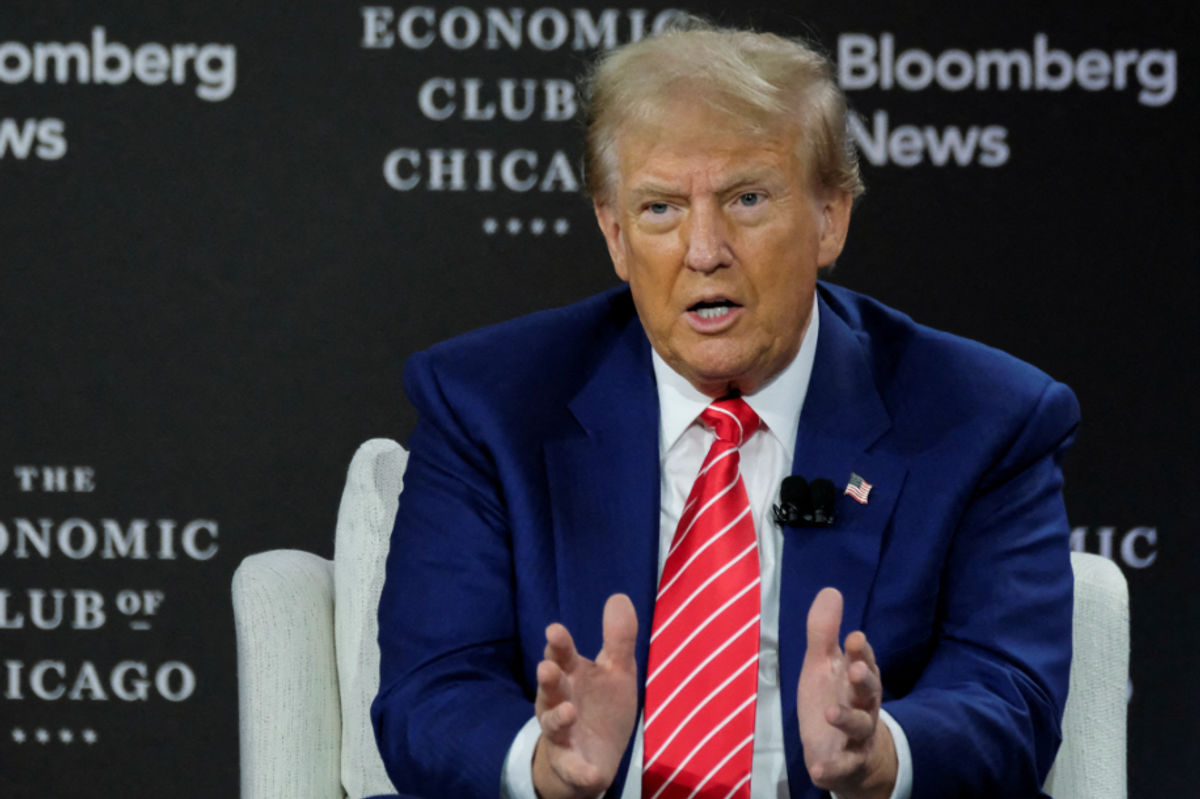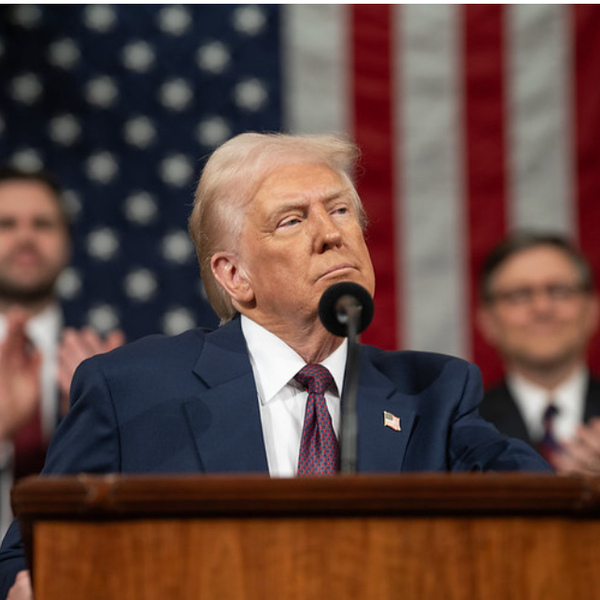
Former President Donald Trump at Economic Club of Chigago on October 15, 2024
A new report from The Budget Lab at Yale University, first previewed in a column published by Bloomberg News, describes the calamitous macroeconomic effects of implementing various tariff proposals endorsed by Republican presidential nominee Donald Trump, which likely include a net loss of economic growth, a decrease in American household incomes, and a renewed burst of inflation.
This analysis highlighting Trump’s potentially ruinous policy agenda comes after months of other mainstream news outlets letting Trump off the hook for proposals that would harm the economy and jump-start inflation.
During an October 15 appearance at the Economic Club of Chicago, which featured an interview moderated by Bloomberg Editor-in-Chief John Micklethwait, Trump repeatedly insisted that if elected, he would implement across-the-board tariffs on imported goods to somehow restore American manufacturing jobs and strengthen the American economy.
Trump repeatedly ignored attempts by Micklethwait to highlight the adverse effects of implementing these policies, baselessly claiming his tariffs would “have a massive effect, a positive effect” on the overall economy and rejecting concerns that his import tax scheme would disrupt supply chains, present obstacles for small businesses, and raise consumer prices.
In an October 16 op-ed published by Bloomberg, economist Ernie Tedeschi previewed a new report produced by his research team at The Budget Lab, which describes in detail the harmful disruptions Trump’s tariff policies would unleash on the American economy.
According to Tedeschi, the research found that Trump’s tariff scheme would raise tax revenues by trillions of dollars, to be paid by American companies and consumers, but the increase in tax revenue would likely be reduced when foreign countries impose retaliatory tariffs against the United States and reduce overall trade flows. The researchers then found that Trump’s tariffs would shrink the size of the American economy by up to 1.4%, or $325 billion annually, which would also shave up to $1 trillion from the tax base and offset some of the taxes raised by the tariffs themselves.
Crucially, Trump's tariff policies would simultaneously result in a burst of additional inflation of up to 5.1% annually (roughly double the current inflation rate) coupled with a net reduction in real household incomes. The average American family would see its purchasing power reduced by “between $1,900 and $7,600,” with the worst effects likely felt by lower-income families.
All told, this new research demonstrates that Trump’s tariff proposals could be a disaster for the United States, and in particular the tariffs could unwind all of the progress made in combating inflation over the past two years of the Biden-Harris administration.
Media Matters has already demonstrated on numerous occasions that many mainstream news outlets have been asleep at the wheel in describing the stakes of Trump’s inflationary policy proposals. With Trump potentially just weeks away from retaking the White House, the American public deserves to know what is truly at stake.
This new report from The Washington Post, which includes the Budget Lab study, is a good start that should be emulated by other mainstream news organizations.
And of course Bloomberg deserves praise for publishing Tedeschi and his team's work to begin with. From his op-ed:
Pundits sometimes claim that US presidential campaigns are devoid of big, consequential policy ideas. That’s clearly not true this time around. Arguably the most profound policy change being proposed in this campaign is former President Donald Trump’s big idea to broadly raise tariffs on imported goods, possibly to levels the US has not seen in many decades.
...
In a series of campaign remarks, Trump has laid out the contours of ideas to raise tariffs back to historical levels. He has suggested broad tariffs on all imports from trading partners that could range from 10% to 20%, and has raised the possibility of a tariff on all Chinese imports of 60%. In remarks in September, Trump floated the idea of a 200% tariff on Mexican imports. The Budget Lab simulated 12 illustrative scenarios that were various combinations of these different rates, and which assumed retaliation and no retaliation from the targeted countries.
Tariffs are, first and foremost, a tax, and Trump’s proposals would indeed raise meaningful revenue that could be used to shrink the federal budget deficit, which totaled $1.8 trillion in fiscal year 2024 ended Sept. 30. Under the most common interpretation of Trump’s proposal — a 10% tariff on all goods imports and a 60% tariff on Chinese goods imports — the US raises $2.6 trillion over 10 years if other countries do not retaliate. Dial the non-China tariffs up to 20% and revenues rise by $4.4 trillion.
But there are several asterisks when it comes to tariffs as a revenue raiser. First, other countries almost certainly would retaliate against the US, and do so almost immediately, as, for example, China did within days when Trump imposed Section 301 tariffs against them in 2018. At The Budget Lab, I found that retaliation leads to the US raising less of its own tariff revenue: 12% to 26% less under each proposal if other countries retaliated. That means the 10% broad/60% China proposal would only raise $2.2 trillion if there was retaliation, and the 20%/60% proposal $3.4 trillion.
Second, the conventional estimates above assume the economy stays fixed in size. In reality, past evidence along with The Budget Lab’s modeling suggest the economy would likely shrink in response to the tariffs, as whatever positive reshoring effects resulting from the tariffs would be more than overwhelmed by rising input costs, falling investment, and lower consumer spending and real incomes. Depending on the scenario, the level of real GDP would decline by 0.5% to 1.4% in the medium-term, which is the equivalent of shaving between $120 billion and $325 billion off the economy today. And a smaller economy means even less tax revenue raised. Using rules-of-thumb from the Congressional Budget Office, this range of GDP effects translates into $400 billion to $1 trillion less dynamic revenue than the conventional estimates. So, the fiscal upside would in fact be even smaller.
Third, prices would rise and real household incomes would decline in response to the tariffs. While a tenth of all consumer spending is on imports, a quarter of consumer goods spending is imported, so the tariffs would pinch households considerably. Consumers would face price increases of 1.2% to 5.1% depending on the specific proposal. That’s like suddenly getting between seven months and 2.5 years’ worth of normal inflation. For the average household, these price increases would lower the purchasing power of their annual income by between $1,900 and $7,600 in 2023 dollars. And since there is evidence that tariffs burden lower-income families more than upper-in ome families, the squeeze would be particularly severe for households that can least afford them.
…
Trump’s tariff proposal could be the biggest shift in US tax and trade policy in generations, and it could raise trillions of dollars in revenue. But as The Budget Lab’s findings show, the downside to the economy is potentially enormous. Pundits complained about not getting big policies; now they have an expensive one to talk about.
Reprinted with permission from Media Matters.








